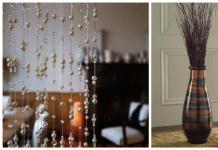Curtains are the main element of the interior. They perform not only a decorating function, but also a protective one, hiding the room from prying eyes and preventing the penetration of bright colors. sun rays. However, in order for the window drapery to look decent, it is necessary to choose the right product design.
Lovers of lightness and airiness most often choose french curtains. Such models are quite voluminous, which gives the room a certain theme. The originality of the design will create a cozy and comfortable space.
Any housewife can sew such curtains on her own. All handmade items are special meaning. To help everyone who wants to try their hand at needlework, we outline below detailed information, where a master class of French curtains will be presented.
What is the design feature?
The traditional design of French curtains came to modern interiors from the distant 14th century. At that time, they were at the peak of popularity and were used to decorate palaces and royal chambers. Of course, only wealthy people could afford such a luxury. However, at present, such drapery has somewhat lost its position to other options. Nevertheless, it still remains quite popular.
French curtains, made by hand, will decorate any room: living room, study, kitchen, bedroom. They will transform the interior, giving it smoothness and softness of lines. This opportunity appears due to a certain style. Its main elements are festoons. It is they who form beautiful lush folds, the distance between them and the number can vary significantly. Their shape is arched, freely hanging.
The width and height of the curtains are determined by the size of the window opening, but you need to remember that they do not move apart. Some models do with lifting mechanism(manual or electric).
A bit of France in the interior
People who want to create a majestic and stylish interior, it is recommended to opt for the classics. It is she who includes everything. necessary elements. Such a space is truly royal, and if it is supplemented with scalloped curtains, then in addition to pomp, romanticism characteristic of the French will appear. To this day, this design is in great demand, and, oddly enough, the design is original.

French curtains for the kitchen, study, living room will look as harmonious as possible if the window openings in the room are large enough. In order to independently create such a style, correctly conveying all the details, you need to familiarize yourself with the key points:
- The length of the curtain can be up to the floor or up to the windowsill.
- The material is selected light and transparent to give airiness to the product.
- The curtain is sewn only from a single piece of fabric.
- Sections with folds should be at least four.
Advantages
- Scallops arranged vertically visually increase the height of the room.
- The appearance of the curtains does not require additional drapery, however, if necessary, you can use thick curtains and lambrequins.
- The original design of the product can decorate any interior.
- If you sew French curtains with your own hands, it will turn out quite inexpensively.
- The installed lifting mechanism makes it easy to raise or lower the window drapery.
- Freely falling folds will save the hostess from time-consuming ironing.
Fulfillment of desires
So, it was decided to sew curtains on their own. Where to start this process? First of all, you need to choose the right material. It must meet the following requirements:
- naturalness;
- ease;
- transparency.
It is not recommended to sew French curtains made of heavy fabrics, as the finished product will look quite rough and too catchy, which will only spoil general impression about the room.

Optimal options:
- tulle;
- atlas;
- silk;
- batiste.
Color spectrum
In order for everything to harmonize in the interior, it is necessary to carefully select the palette. One of the determining factors is the purpose and style of the room. You should also pay attention to the location of the windows. However, even regardless of this, it is highly recommended not to use too bright artificial shades, as they will break the idyll.

French curtains are most harmonious in pastel colors:
- tender peach;
- calm beige;
- white - a classic of the genre;
- sky blue;
- glam pink.
In any case, the choice colors completely individual, depends on personal preferences, but it is still worth considering the recommendations of qualified designers.
Fabric consumption
Before undertaking independent sewing of a French curtain, it is necessary to study the subtlety of the calculation of the material. As a rule, the length of the cornice is taken as the main parameter, and the allowance for folds is also taken into account. Do not forget about the seams, their width is from 1 to 2 cm, so you need to add 4-6 cm to the existing sizes.

The French Curtain pattern shows the exact size between the rings through which the tie cords will be pulled. From this we can conclude that the final length of the product will be significantly reduced. In order to choose the ideal parameter, you will need to measure the desired size and increase this figure by 1.5-2.5 times (the coefficient varies depending on the depth of the folds). Be sure to add 5 cm above and below this length.
Calculation example:
- curtain width: the average length of the cornice is 150-250 cm, multiplied by a factor of 1.5-2 for light folds, by 2.5 for deep scallops;
- curtain height: the length of the wall from the ceiling to the floor or window sill increases by 1.5-2-2.5 times.
How to sew French curtains: a step-by-step description
Having decided on the material, color, having calculated the width and length, you can proceed directly to sewing. It is very important to choose comfortable spot, where it will be possible to freely expand the canvas.
Description of works:
- The fabric is unfolded, the evenness of the cut line on all sides is checked. If there are defects, then it is necessary to correct them with scissors.
- Seam processing. The side edges are tucked up by 1-2 cm, then they are basted and ironed. After that, after checking the quality of work, you can sew with a machine seam.
- The bottom edge is processed in a similar way, however, the size of the hem in the final result should be no more than 0.5 cm.
- On the canvas, make markings according to the pattern (see above) in order to determine the place for sewing the braid with rings. The distance between it should be equal over the entire length of the curtain. After that, baste the braid, checking if it has moved during this process, and, making sure that quality work, finally sew on a sewing machine. At the same time, the ends of the braid are tucked inward so that the wrong parts of the edging and the curtains match.
- A drawstring is threaded through the rings on the braid, fastens the curtains from below and stretches. The top edge is not processed if a lifting mechanism is to be installed.

Finishing touches
The last step in sewing is the processing of the top edge. As a rule, French curtains are attached to a special bar, which is subsequently installed on the eaves. Thanks to this device, the canvas can be aligned directly on window opening, adjusting it to the exact dimensions. However, before attaching to the bar, it is necessary to process the upper edge. To do this, first make a fabric bend 1 cm wide more than the fastening tape. It is advisable to iron so that the material retains its shape. After the tape is sewn on the wrong side. That's all, the French curtain is ready.
If you want to decorate the interior of the kitchen with luxurious, but at the same time light and practical curtains, pay attention to the models of French curtains. They are a single piece of fabric, the length of which can be adjusted at your discretion, turning the fabric with lush scalloped folds using a vertical braid. Having chosen French curtains for the kitchen, they can be used both independently and in an ensemble with other curtains. But in any case, they look elegant, stylish and give the atmosphere of the room a truly Parisian charm and a bit of palatial pomposity.
Curtains with lush scallops were invented to decorate the interiors of banquet halls and bedrooms of the French nobility (which is why their second name is “marquise”), then spectacular textiles began to be used to decorate theater scenes. And today, almost three centuries later, French curtains are still associated with wealth and success, and can decorate the windows of any room in our house - from the interior of a romantic bedroom to cozy kitchen.
Light and airy drapes french style
5 reasons to hang French curtains in the kitchen:
- Short draperies do not block access to the window and window sill, but thanks to spectacular scallops they look much more respectable than Roman or roll structures.
- They go well with other types of window textiles - curtains, lambrequins.

A short curtain in a duet with a luxurious lambrequin fits perfectly into the interior of the kitchen
- The number and splendor of the folds can be varied at your discretion, so the "French" looks great on a small narrow window, as well as on a wide opening.
- Thanks to the lush folds, the French curtain closes the room well from prying eyes, so it can be used even in the kitchen on the ground floor without blinds or thick curtains.
- Such a curtain will be an ideal addition for both expensive historical interiors (classic, baroque, renaissance, empire), and for kitchens decorated in the spirit of a cozy country, romantic Provence or elegant English style.

Lush scallops in a classic kitchen interior
On a note! Many people confuse Austrian and French curtains, because the models are really similar in the form of folds, the lifting principle and a solid canvas. The difference is that French curtains have scallops all the way down and do not fully unfurl even when the curtain is down. And the Austrian ones form folds only in the lower part of the canvas.

Varieties of lifting curtains
Choosing fabric for curtains
French curtains for the kitchen can be of any length - as practical short curtains to the windowsill, and lush drapery "to the floor." There are no special restrictions in the choice of textiles. The material can be airy or quite dense, the difference is in the form of folds (the heavier the canvas, the more clearly the arcs will be expressed). Dense soft tissues will fall in smooth "waves", and the lungs will help form lush "clouds".

Colored transparent textures perfectly scatter light
The most popular types of fabrics:
- Translucent - veil, organza, muslin, silk, cambric, chiffon, tulle, polyester with various additives.
- Opaque - satin, cotton, linen, jacquard.


Plain textile with multi-coloured braid
As for colors, curtains can be any color of the rainbow, although white and other neutral tones are usually preferred. But textiles with a pattern are used infrequently, because when the curtain is raised, the beauty of the pattern can be lost in the folds. But if you really want to revive the interior of the kitchen with a colorful print, use light-colored fabric with a repeating colorful ornament (peas, cage, flowers).

Floral motifs in the interior of the kitchen

Can be used for sewing plain fabrics different colors
On a note! To finish the lower edge of the curtains, you can use lush ruffles, a fringe of gilded threads or glass beads, a spectacular border bright color. The choice of decor depends on the density of the material and the style in which the interior of the kitchen is decorated.
Systems for scalloping
Distinctive feature French curtains - a cascade of even arched scallops. IN classic version curtains are mounted on profile cornices, which allows you to form more lush and expressive folds. In the modern interpretation, the canvas is attached only to the upper holder with special Velcro, like other lifting models.
Types of lifting mechanisms for French curtains:
- Manual - curtains are raised using a system of several cords and rings.

- Automatic - just flip a switch or press a button on the remote control to actuate the roller, which will rotate and gather the shade on desired height on one's own.
The working principle of the automatic lift
On a note! The simplest design of "Frenchwomen" can also be static - that is, the folds will be fixed in one position without a lifting mechanism. For short curtains for the kitchen, this can be a good and very economical solution. .
We sew French curtains with our own hands
Finished Models with lush scallops are quite expensive, but if you have a sewing machine and a desire to create a unique window decor in the kitchen, you can sew french curtains on one's own. Despite the apparent complexity of the design, such work is quite feasible even for a novice seamstress. Therefore, we will consider in detail all the nuances of the upcoming work - from window measurements to the manufacture of the product itself.
Material calculation
The key to success in tailoring any curtains - correct measurements. Therefore, we arm ourselves with a tape measure and go to the kitchen window.
We are interested in four main parameters:
- The length of the cornice, to which a margin of 1.3-1.5 should be added, in order to beautifully drape the opening with fabric and leave an allowance for the seams.
- The height of the future curtain, which is measured from the cornice to the window sill or the middle of the window (however, if we are talking about a kitchen-dining room with a large opening, you can sew a curtain up to the floor).
- Assembly coefficient - depends on the type of textile, splendor and bending of the folds. For dense material, you need to multiply the length of the curtain by 1.8-2, for light tulle, chiffon or veil - at least 2.5.
- The number of stripes with scallops - the length of the cornice should be divided into 4-5 equal segments (or more - depending on the size of the window).
An example of calculating the fabric for a French curtain in the kitchen:
Given: standard window with a two-meter cornice, curtain length - up to the window sill (175 cm).
Determine the width: multiply the length of the cornice by 1.5. Total: 2 m * 1.5 = 3 meters.
We determine the height: we multiply the length to the window sill by 2.5 (assembly factor for lush scallops). Total: 1.75 m * 2.5 = 4.375 m (including allowances - 4.4 m).
To form 8 rows of scallops on the curtain, the fabric will have to be cut into canvases. But if you can find desired material in a narrow roll, 80 cm wide, - this will be perfect option for the beginner seamstress. According to our calculations, such matter will need 17.6 meters (4.4 m * 4 canvases) with a width of each row of folds of 35-40 cm.

Material calculation scheme depending on the number of scallops
In addition to the fabric, you will need a curtain rod for attaching curtains, rings and a skein of nylon cord - all this can be bought at a sewing accessories store. And, of course, you can’t do without a set of home craftswomen - a sewing machine, scissors, thread, needles / pins and a measuring ruler with chalk for marking.
Tailoring technology
To get a spectacular curtain with lush folds, it is important not only to correctly calculate the amount of material, but also to provide tucks in the right places of the drapery, and even correctly fix the rings for the lifting mechanism. In order not to miss any of the upcoming stages of work, we suggest using our hint.
Step-by-step instruction for sewing French curtains with your own hands:
- Sew the pieces of fabric together to obtain the desired width of the curtain.
- Lay out the resulting whole canvas on a table or other flat surface.
- Make a markup, indicating with chalk the location of the center lines of the scallops, taking into account the allowances for the seams (at the bottom and on the side - 5 cm each, and on top - along the width of the curtain tape or Velcro).
- Finish the bottom and sides by folding the fabric twice and secure the fold with a straight stitch.
Advice! For convenience, you can first baste the seams by hand or pin them with pins, and then iron them with an iron.
- Now it remains to form the scallops. To do this, from the sides, along the seams that fastened the strips and along the markings of the center of the scallops, it is necessary to lay a French (or linen) seam, with large stitches through which you can pass the gathering cord. "marquise" tape) and attach to the wrong side of the product with a regular stitch.
On a note! For a curtain under a two-meter cornice from our example, consisting of four sheets of fabric, you will need 9 seams and 9 cord cuts of 175 cm each.
- Then we take a pin, pass the cords through the seam loops and collect the curtain with beautiful folds. After that, you need to tighten each end and sew to the bottom of the curtain. To get beautiful folds, you can make small tucks in the center of each row of scallops or limit yourself to only the first row from the top, allowing the rest to form arbitrary “waves”.

Pattern for sewing French curtains with your own hands
- On the upper edge we make a bend, then we attach a mount to it - a curtain tape or one of the sides of the pile. After that, we adjust the width of the product according to the size of the eaves.
At this stage, you can finish the assembly - the curtain is ready. It remains to smooth the fabric, attach it to the hooks of the eaves or combine the sides of the fluffy tape on mounting plate. But if you want a movable rather than a static curtain, you will have to work a little more.
Installation of the lifting mechanism
In order for the curtain to be adjustable in height, you will need small rings that are sewn at the bottom of the curtain along each edge of the French seam. So that the fasteners are not visible from the front side, it is necessary to make indents - at least 5 cm from the bottom, and 12-15 cm from the top. Also, the rings must be attached on the sides and the seam of the towel in steps of 15-30 cm.
Important! The step depends on the size of the scallops. For small and narrow “waves”, smaller indents are needed, for deep or wide ones, larger ones.

At the bottom of each gathering tape, it is recommended to hang small weights that will evenly hold the fabric in a vertical position (for light curtains, you can use heavy brushes, bead fringe, decorative stones or glass beads). After that, it remains to thread the cuts of the nylon cord through all the rings.
It is done like this:
- The first segment is wound into a ring located in the lower left edge of the curtain, passed through all the rings sewn along the side seam, passes through the cornice and is displayed on the right side.
On a note! The length of the cord will consist of the sum of two lengths of the curtain and the length of the cornice (in our example (175 * 2) + 200 = 550 cm).
- The second cord is tied to the next lower ring, also runs vertically, then along the cornice and leads out to the right.

- All other cords are drawn in the same way, after which their free ends on the right side of the curtain are woven into a beautiful pigtail and fixed on a hook. This will be the control system that will allow you to raise and lower the curtain to the desired height.
Advice! The lengthy process of sewing on rings can be simplified and accelerated if you buy a ready-made "marquise" tape with rings already sewn on.

Ready-made braid for lifting French curtains
Video: step by step master class
Methods for fastening French curtains
Like any curtains, French models can be mounted directly on window frame using adhesive tape, hang on the eaves by hooks and even immediately on the bar (if the loops of the curtain tape are wide enough). But, unlike roll and Roman designs, lush scallops require free space. Therefore, you should not fasten French curtains immediately to plastic windows, and as shown in the photo - on the bar along the edge of the window opening or on the cornice.


Types of holders for French curtains:
- A bar equipped with adhesive tape is an excellent a budget option for static curtains. Models may differ in the type of fasteners for wall and ceiling mounting.

Ready-made cornice with Velcro and a system for wall mount
- Special cornice for lifting curtains - has small loops, hooks, a recess or a cavity for lacing, which adjusts the height of the curtain. Such a holder is very convenient for DIY models - you don’t have to invent a way to mask and evenly place the cords on top of the curtain.
- Eaves with lifting mechanism - turnkey solution for French blinds, already equipped with a system of cords that you just need to pass through the rings and an adjustment chain.

Fastening for French curtains on the eaves with a chain system:

Fastening for French curtains on the eaves

On a note! You can replace the finished cornice with a cut of a metal profile or wooden beam, on which one of the strips of fluff tape should be glued or nailed with small studs (the second part is sewn to the curtain). Additionally, such homemade holder wrapped in fabric or painted in the color of the walls or curtains.

French curtains in the interior of the kitchen are a great alternative to ordinary tulle and a real decoration for kitchen window. And what is important - despite all the sophistication and visual complexity of the design, they are quite easy to sew with your own hands from any suitable material. But if you are not fond of needlework or simply did not have time to acquire sewing machine- no problem. Such a model can be sewn in any studio, providing professional seamstresses with measurements of your window and the fabric you like.
Photo selection of kitchen interiors with French curtains
Luxurious, rich, stylish, solemn - any of these epithets can characterize French curtains. Smooth lines, lush arcuate draperies, cascading vertical rows of soft scalloped folds, combined with a light texture of delicate fabric and magnificent curtain accessories, leave no one indifferent. Looking at them, even the most staunch adherents of laconic interiors begin to think about decorating at least one window in the house with beautiful “French women”. What is the secret of the centuries-old attractiveness of such a phenomenon as French curtains and how they differ from other lifting curtains, we will understand in this article.
History of appearance

It is believed that the description of the first curtains with scalloped folds laid along the entire length appeared in the 17th century in France during the reign of Louis XIV - King - the Sun in the heyday of baroque and classicism. Who exactly came up with decorating the windows not with straight lines, but with canvases gathered along the entire length in cascading rows of festoons, history is silent. Nose light hand by an unknown designer, such curtains for windows quickly gained popularity among the nobility and became the personification of wealth and luxury. They were sewn from natural Chinese silk and decorated with fringe and tassels.

For "French" fabrics, several times more is required than for straight curtains, in addition, numerous scalloped folds do not look on cheap textiles and small windows. Therefore, it is quite clear that ordinary people they were not available, and the people called them "marquises" - by analogy with one of the highest European noble titles.
 Officially, "marquise" is called a fabric canopy for protection from the sun and rain.
Officially, "marquise" is called a fabric canopy for protection from the sun and rain. The second unofficial name has been preserved behind the curtains by aristocrats to this day and leads to confusion of concepts. The fact is that officially awnings are called fabric awnings over windows, used to create a comfortable shaded area on the street in front of houses, cafes and restaurants.

In its original form, the curtains of the marquise are stationary (they do not move apart, do not rise, but simply hang motionlessly to the floor), they look very solemn and pompous and look best in spacious rooms with high ceilings. Therefore, today they are used mainly on stage, in concert and banquet halls, restaurants, spacious halls of country houses.

For owners of average apartments, options for French curtains have appeared, sometimes they are called French blinds, adapted to modern realities:
- Firstly, the length of the canvases was significantly shortened and, for example, in the kitchen, you can hang a French curtain up to the windowsill.
- Secondly, in addition to natural silk, many high-quality, but not so expensive fabrics have appeared today, on which scalloped folds also look attractive: organza, chiffon, cambric, moire.
- Thirdly, cornices for French curtains began to be equipped with lifting mechanisms, both with manual and with electric control that can be attached to hinged windows, which greatly increased their functionality and expanded the scope.
What are modern french curtains
French curtains (marquises) - a cascading variety of lifting curtains. But unlike other lifting models, they come to the fore not with practicality and functionality, but with beauty and the difference in their appearance obvious. At the same time, it is impossible to confuse French blinds with strict Roman blinds with their characteristic even linear folds and laconic rolls, on which there are no folds at all. But they have much in common with the Austrian models: the canvases are divided into vertical sections and assembled into arched folds. French and Austrian curtains the photos below clearly demonstrate the difference between these two species.

The difference lies in the fact that the draperies of the Austrians are not so plentiful: they are formed only in the lower part and are much wider. When unfolded, they are completely straightened, and their length never falls below the window sill. Awnings are curtains, even in the lowered position, consisting of a large number, divided along the entire length into vertical segments of cascading scallops (sagging towards the center of the assemblies). When the curtain rises, they become even deeper and more expressive.
The length of French curtains can be set to any length, both to the window sill or just below it, and to the floor. In addition, they are divided into stationary (fixed) and lifting:

Cornice for French curtains
The cornice for French curtains can be the same as. Depending on the model, it is equipped with a lifting mechanism or a simplified version is dispensed with. At the same time, the fastening of the canvas can be on Velcro tape or on hooks. The photo below shows standard curtain rods for French curtains with an open and closed curtain lift mechanism.

It is worth noting that no matter what fabric (thick or transparent) was used for tailoring, thanks to the abundant and complex drapery, the marquise is able to completely protect the interior of the room from views from the street.
What fabrics are suitable for French curtains
French curtains in the interior are far from the best economical way window decorations. They require fabric several times more than for ordinary curtains. In addition, scalloped folds on cheap fabrics look ugly and primitive, and, despite the fact that modern awnings do not have to be sewn as they used to be from expensive natural silk, it will not be possible to significantly save on textiles either.
Before choosing the French version of the curtains, it is advisable to properly weigh the costs of their manufacture and make sure that they fit well into the interior and the money spent on them will be compensated by the beauty and harmony of the situation.
To make the folds look spectacular, be even and smooth, you need to choose a well-draped, light and soft tissue. These conditions are best met by natural or mixed, with a small addition of polyester fibers, textiles:
- tulle;
- thin silk;
- chiffon;
- batiste;
- moire;
- muslin;
- veil;
- organza.
Such curtains look light and delicate and are used as curtains, both independently and together with curtains made of taffeta, satin, velvet, brocade. At the same time, curtains should also look luxurious and not be lost in the splendor of French curtains.
 French satin curtains
French satin curtains Sometimes awnings are also sewn from dense, but thin, soft and well-draped fabrics. It could be:
- velvet;
- velours;
- curtain wool.
Such curtains do not need partners and look elegant and respectable. Any curtains hung with them would be redundant. But you need to keep in mind that windows with dense opaque awnings look "deaf" and they are suitable only for spacious rooms and corresponding to them in status classic interiors with massive furniture natural wood and gilded or bronzed accessories.
 French velvet curtains
French velvet curtains The appearance of the folds depends entirely on the texture of the fabric: the softer and heavier it is, the more concise and smoother the scallops are. And, conversely, the harder and lighter the material, the more magnificent and embossed they are.
As for the colors, only plain fabrics are suitable for this type of curtains. Any drawing will be lost in numerous scallops, it will look broken, and the curtain will be untidy.
Which rooms and interiors are awnings suitable for?
 French curtains in the bathroom
French curtains in the bathroom Pompous and aristocratic French curtains will not fit into every room. Cascading vertical rows of scallops, expensive fabrics, accessories in the form of fringe, tassels, flowers and beads will look ridiculous and cumbersome on small windows in small rooms and modest interiors. Best of all, "Frenchwomen" look in an exquisite romantic setting of rococo and baroque in the spirit of the 17th-18th centuries with artsy, smoothly curved furniture, crystal chandeliers and bronze figurines.
 French curtains in the interior of the living room
French curtains in the interior of the living room Of course, few people today would think of creating an interior in their home that completely copies the atmosphere of past centuries, but its main signs and general style must be respected. If you want to decorate a small room with awnings, use options adapted to modernity and performing the function of tulle - from transparent white or pastel shades fabrics, up to the window sill, without additional decorations.
 French curtains in the office
French curtains in the office So that the light tulle French curtain does not “play” from the draft and hangs statically, special weights can be sewn to its lower edge.
 A short French curtain complemented by an original pelmet on the kitchen window
A short French curtain complemented by an original pelmet on the kitchen window As for the functional purpose of the rooms in which it is planned to hang curtains of this type, it can be anything - the main thing, as already mentioned, is the surroundings corresponding to the awning. Of course, French curtains look best in a living room or study, but they are used no less often in such non-residential rooms like the bathroom and kitchen (as in the photo above). The only room where their use is undesirable is the nursery. No matter how attractive the “Frenchwomen” are, dust inevitably accumulates in numerous scallops and they often have to be washed, so curtains that are more functional and simple in shape are appropriate for the room where the kids live.

Despite their aristocracy and sophistication, French curtains can make the interior not only elegant, but also cozy and peaceful. The main thing is that they should match the interior and look, and a modern mechanism with a lifting block will help to increase their functionality.
Video: French curtains in the interior
[Rated: 3 Average rating: 3.7]
French curtains- This is a type of curtains, consisting of several separate sections, each of which has many fluffy folds of fabric falling down. Decorating the windows with French curtains, the room is instantly filled with luxury. As a rule, there are folds of fabric along the entire height of the curtain, which allows you to create exquisite decoration any window opening.
Designer: Alexandra Tkachenko
Origin History
French curtains came to us from the era of the dominance of solemn classicism. Distinctive features such curtains - pomposity and underlined luxury. French curtains, with their many light draperies, are associated with royal apartments, castles of the 18th century and, of course, the theater curtain. Traditionally, French curtains have been used in reception rooms, ceremonial halls to give the room more solemnity - both in public and private interiors. Despite the fact that more than three centuries have passed, French curtains are still in demand in interior decor.
At first, French curtains were often decorated with lace, most importantly - more ruffles. Nowadays, they are often made of transparent elastic so that the drapery lies in smooth folds.
Mechanism and installation
French curtains are very easy to use, they are a single piece with airy lush flowing folds. Cords are threaded through rows of loops along the lower edge, and when they are pulled together, scallops are formed. The folds in the French curtain are preserved along the entire length, regardless of whether the curtain is raised or lowered - this distinguishes the French curtain from the Austrian one.
Curtains can be lifting or static. Static curtains
hang motionless and cannot be moved to any side or lifted up. They are made, as a rule, from light translucent fabrics, for example, chiffon, organza, and perform the function of tulle. 
Second - lifting curtains
- are the most common. They have adjustment sunlight carried out using a lifting rotary-chain mechanism - they simply rise to the top of the window and are fixed with a special lock. At the same time, when lifting up, more folds form and the curtains become more lush, gathering into beautiful “clusters”. 
Length of the product can be different: both to the floor itself, and covering only the window opening. Shortened versions of such curtains that reach the windowsill, and the lower part of the wall under the window remains open, are ideal for the kitchen.
Fabric, patterns and decor of French curtains
For the manufacture of French curtains, silk is used (recently replaced by polyester), as well as translucent tulle.
Textile for this type of curtains, translucent and light textures are mainly used, such as: silk, cambric, wool, muslin, moire, satin. If speak about color solution, then often choose a fabric of light pastel colors(beige, peach, cream, pale blue), but very often French curtains are made from white fabrics. French curtains look noble not only separately, but also perfectly combined in composition with classic curtains or lambrequins, can be emphasized with decorative braid or fringe.
Ruffles, ribbons and ruffles create a visual illusion of volume by refracting light for a dressy look. home comfort. Satin or silk folds effectively emphasize the grace and nobility of curtains of unique French design.
Rooms and style
Such decoration windows fit For classical style . They will also suit rooms decorated in the Empire style with its pomposity and chic, as well as in luxury styles baroque and neoclassicism.
In the living room they will represent comfort, in the bedroom- romance office they will give presentability, and kitchen - luxury. For each room it is better to choose suitable fabric and a model of French curtains. For example, curtains with an abundance of ruffles and frills made of soft draped fabric pastel colors perfect for the bedroom. In the living room, you can combine light draperies in combination with heavy curtains. But French curtains for the kitchen can be made of translucent organza, have a minimum of folds and a floral ornament.
French curtains in the interior look best in spacious rooms, because in a room with a modest size such chic curtains cannot reach their full potential.
Photos of interiors with French curtains:
The whole world admires French curtains and for many centuries their style was considered a sign of well-being and prestige, wealth and solidity. Curtains can emphasize not only the high cost of decoration, but will demonstrate the impeccable taste of the owner of an apartment or house.
French curtains are distinguished by the presence of several sections and fluffy folds of fabrics falling down along the entire length. Curtains can be long, medium and relatively short (these are usually used for kitchens).The first type is static curtains. They are also called stationary. They are not always convenient to use, as they hang motionless. Their design does not provide for movement up or to the sides. Typically, such curtains are made of light translucent fabrics and perform the function of tulle.
The second type is lifting curtains. They are more common than stationary. With the help of a special clamp, you can adjust their appearance and length. You can lift the curtains up, then even more folds will form, and they will be more magnificent.
French curtains in the interior
Best of all, these curtains are suitable for spacious rooms. To make them look good small room, it is important that they are not very lush, and there are not too many folds.If the room is decorated in modern style - such curtains will become its integral part. If the bedroom is decorated in this style, curtains of different lengths will look good. This will give the room a casual and romantic feel.
Also, French curtains will look good in a room that is decorated in classical style. Especially if there is a classic or antique furniture, then such curtains will only add solemnity to the interior.
DIY French curtains
Of course, it will not be difficult to find and buy French curtains. But if a person has some sewing skills, you can do them yourself.First you need to decide on the fabric. It can be thin cotton or linen, silk or satin. The next thing to do is to calculate the fabric consumption. To do this, measurements of the window are carried out and, based on the results obtained, it is calculated how much tissue is needed. For this, the following is used: the width of the window must be multiplied by one and a half, and the height by two.
When sewing curtains, it is important to follow a certain order:
1. Before starting work, the fabric is processed and the decathing procedure is carried out.
Decating is a wet-heat treatment of fabric for its shrinkage.
2. After the fabric on the floor. On the sides, bends are made twice 1-1.5 cm wide and hemmed.
3. At the bottom of the fabric, a 2 cm wide hem is made and also hemmed.
4. Cords are threaded into hemmed seams.
5. After the drapery is performed. Markings are made along the width of the fabric every 45-50 cm, and then a piece of fabric 3 cm wide is sewn vertically, bending the edges inward. Thus, the drawstrings are formed. Cords are threaded through them and fixed at the top. The bottom ends are free.
6. A tape is sewn in the upper part of the canvas to secure the curtains to the cornice.
In addition to their luxury and pomposity, French curtains add calm and comfort to the room. And they always unobtrusively pay attention to the wealth and success that reign in the house.
Usually, the fabric for French curtains is chosen in a single color, but in exceptional cases, a fabric with a light, unobtrusive pattern can be used.
Usually, the fabric for French curtains is chosen in a single color, but in exceptional cases, a fabric with a light, unobtrusive pattern can be used.



















